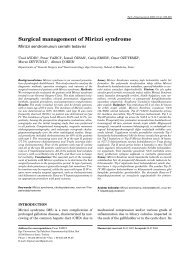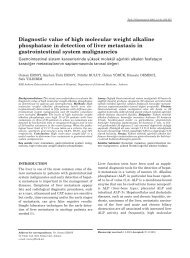Inflammatory myoglandular polyp: A rare cause of hematochezia
Inflammatory myoglandular polyp: A rare cause of hematochezia
Inflammatory myoglandular polyp: A rare cause of hematochezia
You also want an ePaper? Increase the reach of your titles
YUMPU automatically turns print PDFs into web optimized ePapers that Google loves.
Turk J Gastroenterol 2004; 15 (2): 117-119<br />
<strong>Inflammatory</strong> <strong>myoglandular</strong> <strong>polyp</strong>: A <strong>rare</strong> <strong>cause</strong> <strong>of</strong><br />
<strong>hematochezia</strong><br />
İnflamatuar myoglandüler polip: Nadir bir hematokezya nedeni<br />
Burçak KAYHAN 1 , Fikri KÜÇÜKEL 2 , Meral AKDOĞAN 3 , Ersan ÖZASLAN 1 , Tevfık Ali KÜÇÜKBAŞ 2 ,<br />
Ömür ATOĞLU 4<br />
Ankara Numune Hospital Department <strong>of</strong> Gastroenterology Clinic 1 , Ankara<br />
Ankara Güven Hastanesi General Surgery and Gastroenterology 2 , Ankara<br />
Türkiye Yüksek İhtisas Hospital, Department <strong>of</strong> Gastroenterology Clinic 3 , Ankara<br />
Gazi University Medical Faculty Department <strong>of</strong> Pathology 4 ABD, Ankara<br />
<strong>Inflammatory</strong> <strong>myoglandular</strong> <strong>polyp</strong> is characterized by inflammatory<br />
granulation tissue in the lamina propria, proliferation<br />
<strong>of</strong> smooth muscle, and hyperplastic glands with variable cystic<br />
change. The etiology is obscure. Mucous diarrhea, tenesmus,<br />
and <strong>hematochezia</strong> are main symptoms. We hereby report an 80year-old<br />
man with diagnosis <strong>of</strong> inflammatory <strong>myoglandular</strong><br />
<strong>polyp</strong>.<br />
Keywords: <strong>Inflammatory</strong> <strong>myoglandular</strong> <strong>polyp</strong>, <strong>hematochezia</strong><br />
INTRODUCTION<br />
Nakamura first described a new benign colorectal<br />
epithelial <strong>polyp</strong> in 1992, which was termed inflammatory<br />
<strong>myoglandular</strong> <strong>polyp</strong> (IMGP) (1). Its characteristic<br />
histopathologic features are inflammatory<br />
granulation tissue in the lamina propria mucosa,<br />
proliferation <strong>of</strong> smooth muscle, and hyperplastic<br />
glands with occasional cystic dilatation (1).<br />
In this report, we describe another case <strong>of</strong> inflammatory<br />
<strong>myoglandular</strong> <strong>polyp</strong> in the sigmoid colon.<br />
CASE REPORT<br />
A 82-year-old man was admitted to the emergency<br />
service with <strong>hematochezia</strong>. History revealed right<br />
hemiplegia for five years. Colonoscopy showed a<br />
pedunculated large <strong>polyp</strong> (>6 cm) with a reddish<br />
smooth surface (Figure 1), and multiple diverticula<br />
in the sigmoid colon. Histopathologic examina-<br />
Address for correspondence: Burçak KAYHAN<br />
PK 203 06443 Yenişehir / Ankara, Turkey<br />
E-mail: burkaygastro@hotmail.com<br />
inflamatuar myoglandüler polip lamina proprianın inflamatuar<br />
granülasyon dokusu, düz kas hücrelerinin proliferasyonu,<br />
glandların hiperplazisi ve nadiren kistik dilatasyonu ile karakterizedir.<br />
Etyolojisi bilinmemektedir. Mukuslu ishal, tenesmus<br />
ve hematokezya en sık görülen semptomlardır. Burada 80 yaşında<br />
inflamatuar myoglandüler polip tanısı alan bir olgu sunuldu.<br />
Anahtar kelimeler: İnflamatuar myoglandüler polip,<br />
hematokezya<br />
Figure 1. Colonoscopic appearance <strong>of</strong> the <strong>polyp</strong><br />
Manuscript received: 20.01.2004 Accepted: 23.03.2004
118 KAYHAN et al.<br />
Figure 2a (H. E. x 40) - 2b (H. E. x 200). Both <strong>of</strong> the figures reveal the pathological specialities <strong>of</strong> inflammatory<br />
<strong>myoglandular</strong> <strong>polyp</strong>.Histopathologic examination <strong>of</strong> the specimen showed inflammatory granulation in the lamina<br />
propria mucosa, proliferation <strong>of</strong> smooth muscle and hyperplastic glands with cystic dilatation<br />
tion <strong>of</strong> the specimen showed inflammatory granulation<br />
in the lamina propria mucosa, proliferation<br />
<strong>of</strong> smooth muscle and hyperplastic glands with<br />
cystic dilatation (Figures 2a, 2b). The <strong>polyp</strong> was<br />
diagnosed as inflammatory <strong>myoglandular</strong> <strong>polyp</strong><br />
based on the characteristic histological features.<br />
The patient underwent a left hemicolectomy after<br />
which all symptoms disappeared.<br />
DISCUSSION<br />
<strong>Inflammatory</strong> <strong>myoglandular</strong> <strong>polyp</strong> has been characterized<br />
as a solitary, non-neoplastic <strong>polyp</strong> consisting<br />
<strong>of</strong> inflammatory granulation tissue in the<br />
lamina propria, proliferation <strong>of</strong> muscularis mucosae,<br />
and hyperplastic glands with variable cystic<br />
change (1-6). IMGP is solitary, pedunculated and,<br />
<strong>rare</strong>ly, covered by a fibrin cap. Also, IMGP has no<br />
association with inflammatory bowel diseases and<br />
is located not only in the rectosigmoid, but also in<br />
the descending and transverse colon (7). In our case,<br />
the localization was in the sigmoid colon.<br />
Although the etiology <strong>of</strong> IMGP remains uncertain,<br />
Nakamura (1) proposed that chronic trauma from<br />
intestinal persitalsis may contribute to the pathogenesis<br />
<strong>of</strong> IMGP. Since IMGP has never been reported<br />
to accompany neoplasia to date (1-6) endoscopic<br />
<strong>polyp</strong>ectomy alone seems to be sufficient treatment.<br />
However, our patient had a <strong>polyp</strong> that<br />
was too large for endoscopic removal, and we preferred<br />
surgery for this case. On the other hand,<br />
there has been controversy about whether IMGP<br />
is clinicopathologically distinct from mucosal prolapse<br />
syndrome, inflammatory cloacogenic <strong>polyp</strong>,<br />
inflammatory cap <strong>polyp</strong>, and <strong>polyp</strong>oid prolapsing<br />
mucosal folds <strong>of</strong> diverticular disease (6). Many<br />
<strong>polyp</strong>oid conditions throughout the gastrointestinal<br />
tract have been thought to be due to mucosal<br />
prolapse (8). Also, mucosal prolapse may be the<br />
etiological <strong>cause</strong> <strong>of</strong> <strong>myoglandular</strong> <strong>polyp</strong>. This en-
<strong>Inflammatory</strong> <strong>myoglandular</strong> <strong>polyp</strong> 119<br />
tity bears similarity to <strong>polyp</strong>oid prolapsing mucosal<br />
folds in diverticular disease as reported by<br />
Kelly (9). Nakamura pointed to the fact that patients<br />
who had <strong>myoglandular</strong> <strong>polyp</strong>s usually had diverticuli<br />
in the sigmoid colon (1). In accordance<br />
with this report, our case had multiple diverticula<br />
in close proximity to the main pathology. IMGP<br />
was composed <strong>of</strong> inflammatory granulation tissue,<br />
hyperplastic glands, and proliferation <strong>of</strong> smooth<br />
muscle in a radial fashion but never showed the<br />
villous architecture usually found in the mucosal<br />
prolapse syndrome (10). <strong>Inflammatory</strong> cloacogenic<br />
REFERENCES<br />
1. Nakamura S, Kino I, Agaki T. <strong>Inflammatory</strong> <strong>myoglandular</strong><br />
<strong>polyp</strong>s <strong>of</strong> the colon and rectum: a clinicopathological study<br />
<strong>of</strong> 32 pedunculated <strong>polyp</strong>s, distinct from other types <strong>of</strong><br />
<strong>polyp</strong>s. Am J Surg Pathol 1992; 16: 772-9.<br />
2. Griffiths AP, Hopkinson JM, Dixon MF. <strong>Inflammatory</strong><br />
<strong>myoglandular</strong> <strong>polyp</strong> causing ilo-ileal intussusception. Histopathology<br />
1993; 23: 596-8.<br />
3. Gomez NE, del Rio MJV, Sarasa CJL, Melere CE. Myoglandular<br />
inflammatory <strong>polyp</strong> located in the distal end <strong>of</strong> rectum.<br />
Rev Esp Enferm Dig 1994; 85: 45-6.<br />
4. Nagata S, Sumioka M, Sato O, et al. Five cases <strong>of</strong> inflammatory<br />
<strong>myoglandular</strong> <strong>polyp</strong>. Nippon Shoukakibya Gakkai<br />
Zasshi 1998; 95: 145-50.<br />
5. Bhardwaj K, Mohan H, Chopra R, et al. <strong>Inflammatory</strong><br />
<strong>myoglandular</strong> <strong>polyp</strong> <strong>of</strong> the rectum. Indian J Gastroenterol<br />
1998; 17: 63-4.<br />
6. Harada N, Chijiwa Y, Yao T, et al. <strong>Inflammatory</strong> <strong>myoglandular</strong><br />
<strong>polyp</strong>. J Clin Gastroenterol 1999; 29: 104-5.<br />
<strong>polyp</strong> is a solitary, pedunculated <strong>polyp</strong> with tubulovillous<br />
architecture only at the anorectal transition<br />
zone (11). Also, it is known that inflammatory<br />
<strong>myoglandular</strong> <strong>polyp</strong> has to be distinguished from<br />
other <strong>polyp</strong>s be<strong>cause</strong> <strong>of</strong> its different clinical features.<br />
Mucous diarrhea and tenesmus are the most<br />
common symptoms <strong>of</strong> patients with inflammatory<br />
cap <strong>polyp</strong> (12), while the main symptom <strong>of</strong> IMGP<br />
is <strong>hematochezia</strong> (1-4). However, the <strong>cause</strong>s <strong>of</strong> inflammatory<br />
<strong>myoglandular</strong> <strong>polyp</strong> are still obscure,<br />
and further accumulation <strong>of</strong> cases may disclose<br />
their pathogenesis.<br />
7. Bhathal PS, Chetty R, Slavin JL. Myoglandular polps. Am<br />
J Surg Pathol 1993; 17: 852.<br />
8. Bartolo DCC, Warren BF. Refractory solitary rectal ulcer<br />
syndrome. In: Dorbrilla G, Bardhan KD, Steele A, eds.<br />
Non-responders in Gastroenterology. Milan: Cortina International-Raven<br />
Press, 1991; 169-80.<br />
9. Kelly JK. Polypoid prolapsing mucosal folds in diverticular<br />
disease. Am J Surg Pathol 1991; 15: 871-8.<br />
10. Nakamura S, Kino I. Letters to the editor (authors' reply).<br />
Am J Surg Pathol 1993; 17: 751.<br />
11. Saul SH. <strong>Inflammatory</strong> cloacogenic polp: relationship to solitary<br />
rectal ulcer syndrome/mucosal prolapse and other<br />
bowel disorders. Hum Pathol 1987; 18: 1120-5.<br />
12. Williams GT, Bussey HJR, Morson BC. <strong>Inflammatory</strong> 'cap'<br />
<strong>polyp</strong>s <strong>of</strong> the large intestine. Br J Surg 1985; 72: 133.
















